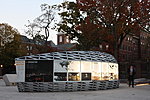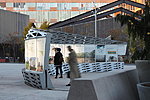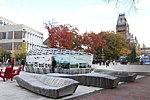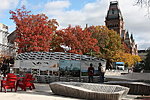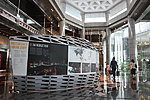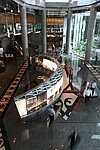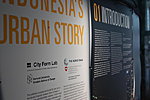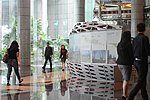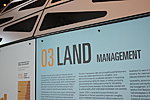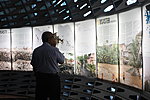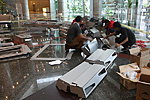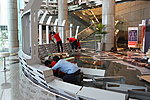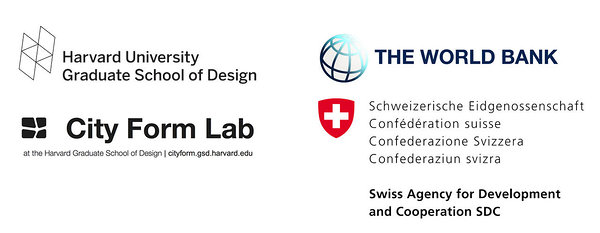Indonesia's Urban Story exhibit
The City Form Lab is opening the "Indonesia's Urban Story" exhibit at Harvard Plaza on Wed, November 16th at 4PM. The exhibition is a collaboration with World Bank Indonesia, describing the trends and challenges related to urban development in one of the most rapidly urbanizing countries in the World. It tells a visual story about the state of urbanization in Indonesia using data visualizations and photographs taken in a number of Indonesian cities in the fall of 2015. The exhibit was developed in conjunction with a World Bank publication “Indonesia’s Urban Story” (2016). This traveling exhibit was previously shown at the Indonesian Stock Exchange lobby in October 2016.
01 Introduction
Exhibit PDF
Indonesia is undergoing a major and rapid structural transformation, from a predominantly rural and agriculture-based economy, to an urban and services-based economy. This structural shift is significant, as increasing urban formal employment and associated productivity gains will drive Indonesia’s ability to generate and share prosperity. However, a large urban infrastructure deficit, slow gains in labor productivity, and rising inequality pose challenges to future growth and prosperity.
Indonesian cities are growing at a rate that exceeds other Asian countries. The urban population increased at an average annual rate of 4.1 percent between 2000 and 2010 (compared to 3.8 percent in China, 3.1 percent in India and 2.8 percent in Thailand) (World Bank 2012). In 2012, the urban population reached over 52 percent of total population. By 2025, an estimated 68 percent of Indonesians will live in urban areas (World Bank 2014).
In Indonesia, as in other countries, urbanization has occurred in tandem with economic growth, rising incomes and poverty reduction. In 2010, over 44% of Indonesia’s non-petroleum GDP was produced in cities (Lewis 2014). Of the 21 million jobs that were created from 2001 to 2011, 18 million were in urban areas and 17 million were generated in the services sector, marking a major shift of the employment base towards cities.
Yet, Indonesia is not benefiting from all the positive returns to urbanization that other countries have experienced. Many Indonesian cities suffer from ‘diseconomies of scale’, such as severe traffic congestion, pollution and disaster risks. In Jakarta, congestion is estimated to cost approximately US$6.5 billion annually (JICA and Bappenas 2004). Serious flooding affected 17% of the Jakarta metropolitan area in 2014, displacing 64,000 people (Ika 2014).
A deficit in urban infrastructure is limiting the ability of Indonesia’s cities to deliver shared prosperity and poverty reduction. Urban infrastructure quality is poor in Indonesia, and access to basic services, such as clean water, sanitation, electricity, and transportation, has remained generally limited and not well distributed. In 2009, only 50 percent of urban population had access to safe water, while sewerage coverage only existed in 11 cities, with 2 percent of urban population having access to centralized sanitation systems (World Bank 2014).
This exhibit offers an overview of some of Indonesia’s urban challenges, exploring the role of cities in driving sustainable social and economic development. It focuses on five themes that characterize the growth and development of Indonesia’s cities: housing, transportation, land management, disaster risk management, and solid waste management.
Credits
| Harvard GSD, City Form Lab | World Bank Partners |
| Andres Sevtsuk Exhibit curation and design Asst. Professor of Urban Planning Harvard GSD | Marcus Lee Senior Urban Economist, World Bank |
| Raul Kalvo Design and fabrication | Tuo Shi Economist, World Bank |
| Lily K. Song Research and writing Senior Research Associate, Harvard GSD | Taimur Samad Program Leader, World Bank |
| Caleb Ming Photography Surround Studio, Singapore | Matt Steele Urban Economics and Planning, World Bank |
| Haibei Peng Graphic Design MArch candidate, Harvard GSD | Mateo L. Zúñiga, Andrés Barragán Inforgraphics Puntoaparte Bookvertizing |
| Judy Zheng Jia Background research Research Assistant, SUTD | |
| Ragnar Voolaine Fabrication Redhat Group, Estonia |

02 Housing
Indonesian cities lack quality affordable housing. Urbanization and population growth mean that an estimated 820,000 to 920,000 new units are needed in urban areas each year because of new household formation and migration to cities.[1] The private sector only produces approximately 400,000 units per year and an additional 150,000 to 200,000 units are delivered by the public sector. This leaves a gap of 220,000 to 370,000 households that must resort to self-initiated solutions or overcrowding in existing units each year. In addition, there is a massive quantitative and qualitative housing deficit, estimates of which range from 3.5 to 17 million units depending on which criteria are used.[2]
Indonesia’s kampungs, or dense urban villages, house a majority of low income households in urban areas. Typically characterized by incremental growth, self-financing and construction, and shared basic infrastructure and services, urban kampungs house longtime residents over generations and provide shelter to new migrants. However, newly established kampungs in insecure inner city sites provide limited tenure security and are vulnerable to hazards such as landslides and flooding. Even the more established and well-to-do kampungs in central areas risk demolition and displacement to make way for new, larger scale development projects due to developer buy-outs and evictions.
Lack of access to housing finance and the high cost of land in inner city areas mean that low-income households often resort to squatting or, in a best case scenario, purchasing housing on the urban periphery. These households end up paying premiums for transportation and other costs, with negative impacts for the spatial and socio-economic development of Indonesian cities. An estimated 12.2 percent of urban residents currently live in slums.[3] Many of these slum and squatter areas are not legally recognized and therefore lack basic services, becoming zones of exclusion and poverty.
Access to well-located affordable housing in Indonesia is constrained by a number of factors. On the demand side, limited financial inclusion, low incomes, and limited household saving restrict access to the formal housing sector. Over 60 percent of Indonesians are not part of the formal workforce and hence have limited access to the financial system.[4] Many of these households may be able to afford a housing loan, but lack credit histories and are considered unbankable by the commercial banking sector. Unlike in countries like India or Mexico, the financial sector in Indonesia has not yet developed innovative underwriting and credit risk management solutions to provide housing solutions to low-income and non-salaried earners. As a result, only the richest 20 percent of households can acquire housing in the formal commercial market. The middle 40 percent of households require mortgage subsidies to access housing, while the bottom 40 percent of Indonesians cannot afford a formal basic unit without deep government assistance.
On the supply side, land availability bottlenecks, including complex land acquisition, permitting and servicing processes, constraints on developer finance, and rising land and construction costs have limited formal housing development. Developers have little incentive to build for the low-cost market, instead preferring to maximize profits where strong demand from higher-income families or investors exists.
To address these issues, the Government of Indonesia has developed a number of policies and institutions to support affordable housing. These include a series of neighborhood development programs, highly to fully subsidized public rental programs, an up-front subsidy for incremental home improvements, and a subsidized Mortgage Liquidity Facility. In addition, several state-owned enterprises, including the National Affordable Housing Corporation, PT Perumnas, are entrusted to play an active role in improving supply of and access to affordable housing. Unfortunately, these initiatives and institutions have not yet been effective in improving housing outcomes at sufficient scale, and government spending on housing has not always been equitable or effective.
Some local governments have pioneered programs that have achieved local results: for example, a housing microfinance scheme in Palembang, and a rental housing program administered by DKI Jakarta. However, these local initiatives often lack sustainable funding and the political support to be scaled up. Surabaya, the second largest city in the country, offers better municipal housing solutions than most cities in Indonesia, but it only has a dozen municipal housing blocks for a metropolitan population of 7.3 million, with most of them located in the municipal periphery.
03 Land Management
Exhibit PDFIndonesian city governments widely lack adequate data and information on land and property making urban management and planning difficult. The absence of accurate and robust land and parcel data inhibits local governments’ ability to collect property taxes and achieve necessary public service provision. There is also a lack of coordination and consistency among the public institutions tasked with land titling and cadastral surveying.
The bottlenecks in land titling, private property rights (including those pertaining to informal but valid land tenures), and land records (notably the lack of comprehensive digital cadastral maps) not only stoke social conflict between long term residents and urban renewal forces, they further disadvantage private landowners and developers in land assembly negotiations with state institutions. Urban redevelopment often induces forced evictions, inadequate compensation and social unrest, disproportionately affecting low income households in informal settlements.
The lack of transparency, data and a straightforward development process also creates opportunities for corruption. Local administrations exercise considerable discretion in interpreting laws and allocating rights with respect to holding, purchasing, and developing land, creating opportunities for rent seeking. Consequently, private developers tend to develop suburban and ex-urban projects, which entail easier and cheaper land assembly.
Law No. 2/2012 is expected to improve the clarity and transparency of the land acquisition process and strengthen public confidence in the Government’s efforts to advance the infrastructure agenda. Drawing on the lessons learned from the Presidential Decree No. 36/2005, this law has helped to increase public confidence. Areas of significant improvement include the process for land valuation, procedures for acquiring land for public infrastructure, the mechanisms for addressing grievances, and compensation for affected or displaced individuals. For instance, the new regulation provides specifics about the inventory of affected people and assets, the consultation process, compensation, and dispute settlement. It also sets a specific timeframe for each of the acquisition stages and sub-stages, including the maximum time that a court may take to resolve disputes related to land acquisition..
Meanwhile, some municipalities have been exploring innovative, democratic and equitable approaches to urban land use planning and management. In Solo, the municipality relocated street vendors from Banjarsari Park, where many unemployed workers had congregated in the aftermath of the Asian financial crisis, to the purpose-built Pasar Klitikan Notoharjo in Semangi. The process of relocation (2005-2008) followed two years of meetings and negotiations with street vendors. Then-mayor Joko Widodo (Jokowi, who was elected president of the Republic of Indonesia in 2014) engaged in over 50 open dialogue sessions over lunch with the vendors. In doing so, the government gained input from vendors on how to improve the connectivity and visibility of the relocation site and offered concessions such as stall ownership certificates and access to business loans. The final relocation from Banjarsari to Klitikan was marked by a parade, which drew further public attention.
04 Transportation
Exhibit PDFGrowing traffic congestion, vehicle emissions, and related air pollution constitute some of the most challenging policy and planning dilemmas in Indonesian cities. The combination of rapid urbanization and sprawling, low density development has lengthened commutes and intensified public reliance on motorized transportation. In part, lower urban densities and auto-oriented development result from cultural preferences for low-rise living (as embodied by the traditional kampungs) and high levels of natural disaster risk have historically constrained multilevel construction. However, it is also attributable to policy factors such as a focus on expanding road networks to connect suburban to central city areas, rather than improvement of urban public transportation, as well as lack of coordination between land-use planning and transport infrastructure development.
The last decade has seen an explosion of car and especially motorcycle ownership. Motorcycles are popular among urban dwellers due to their affordability, and ability to maneuver through dense traffic and narrow streets. Because motorcycles represent 82 percent of vehicles in Indonesia, many blame them for increased congestion and pollution problems. City governments have promoted policies to curb their use, but there has not been comparable scrutiny and treatment of cars, which are even more space consuming and polluting.
A major incentive for private motorization has also been the lack of reasonable alternatives. While city governments across Indonesia are clearly interested in promoting good urban planning, comprehensive urban transportation infrastructure has yet to be implemented. Although Jakarta undertook extensive Bus Rapid Transit (BRT) planning and implementation in the early 2000s, the BRT is still limited by challenges of infrastructure and vehicle maintenance, and has been criticized for having irregular travel times for not making full use of existing infrastructure capacity. Jakarta and Surabaya have adopted car-free days and promoted cycling and walking.
The transport systems of most Indonesian cities also include angkots (fixed-route mini vans), ojeks (motorcycle taxis) and becaks (bicycle taxis), offer additional transport options. The ojeks and becaks are especially useful in navigating densely built kampung environments, inaccessible by fixed route buses and minibuses. Decreasing a reliance on individualized transport and taxis, new services like GO-JEK and Grab Bike enable app-based hailing of motorcycle taxis. Aside from being affordable and providing vital mobility services to the urban poor and populations with special needs (e.g. women, children, street vendors), the urban transport sector provides much needed employment opportunities to unskilled, low wage workers. Despite concerns about vehicle safety and worsened traffic congestion (as a result of haphazard stops), these transport modes help fill the growing demand for mobility in Indonesian cities.
Improvements in urban street networks are needed. Most traffic flows to arterials and highways span very large blocks and are sparsely connected with the local street networks at severely bottlenecked entrances and exits. The remaining traffic is on local, narrower streets, which are often winding, unpaved, and prone to flooding. Yet arterial densification and street widening risk demolishing pedestrian-centric kampung lanes and inducing traffic that would not have existed without such improvements. Hence, cities like Surabaya are exploring land use planning and development strategies that encourage greater porousness and connectivity between urban kampungs and major roads, to promote alternative transportation patterns and achieve higher accessibility and mobility at the neighborhood scale.
05 Solid Waste Management
Exhibit PDFWith rapid urbanization and rising income levels, Indonesians are generating growing volumes of solid waste, particularly in large cities. It is currently estimated that approximately 85,000 tons of solid waste is generated daily in Indonesia, with this amount expected to increase to 150,000 tons by 2025. In most Indonesian cities, municipal solid waste management systems are inadequate, and collection rates are low. Estimates suggest that only about half of all municipal solid waste urban solid waste is collected.
When solid waste is not collected, it is often openly burned, informally buried, or disposed in streets, canals, rivers, and parks. Solid waste burning can be a significant and costly source of air pollution in urban areas. Waste burning contributes to respiratory infections for urban residents resulting in significant health damages and lost working days. When waste is disposed of in waterways, it can cause blockages and subsequent urban flooding. In addition, there are significant costs for regularly dredging canals to remove improperly disposed waste.
Of the solid waste that is collected, most is not disposed in a sanitary landfill with appropriate environmental and social standards. In 2006, the Ministry of Public Works (MPW) issued a regulation (21/Prt/M/2006) mandating that all open dump landfills be either closed or upgraded to sanitary facilities by 2011. In 2008, the Waste Management Act (No.18/2008) again required all local governments to close open dumping sites by 2013. However, few sanitary landfills are currently operational and open unsanitary landfills remain the norm. These landfills can have numerous negative consequences, such as groundwater and surface water contamination, air pollution and hazardous working conditions for waste pickers.
Following decentralization reforms, the national government’s role was limited to an advisory and regulatory role, while municipal governments are the primary implementers. This was established in Presidential Decree No.2/2002 and reaffirmed in the Waste Management Act (No.18/2008). Yet, the finances available to local governments have been insufficient for the high recurrent expenditures needed for collecting waste, and for constructing and maintaining sanitary landfills. Local waste collection fees and municipal budget allocations for solid waste management are typically low.
The informal sector also plays a significant role in the management of municipal solid waste in Indonesia. Waste pickers collect recyclable materials from households, businesses, streets, transfer stations, and landfills before sorting and selling them to brokers. Waste picking provides a source of income and livelihoods, but waste pickers tend to work in extremely poor and dangerous conditions, often without adequate protections. Incomes from waste picking are unstable, subject to the fluctuating prices in the markets for recyclables.
Many municipalities and local communities have also initiated recycling and composting activities. NGOs have partnered with urban poor communities to start community recycling programs, such as “bank sampah” or “waste banks” that aggregate recyclables at the community level. These alternative approaches for managing solid waste at the local level have attempted to fill the gap in managing the growing volumes of solid waste in Indonesian cities.
06 Disaster Management
Exhibit PDFWith regular earthquakes, volcanic eruptions, tsunamis, floods, forest and land fires, Indonesia is more vulnerable to natural disasters than most other countries. Over the last 30 years, Indonesia experienced 289 significant natural disasters per year, with an average annual death toll of approximately 8,000.[1] The period between 2004 and 2010 was especially calamitous, beginning with the Indian Ocean earthquake and tsunami, which claimed almost a quarter million lives and left half a million homeless. After a series of earthquakes and tsunamis in Sumatra and Java in the following years, 2010 brought a volcanic eruption in Java, which destroyed almost 3,000 homes and displaced 350,000 people.[2]
In 2007, the Indonesian government enacted the Disaster Risk Management Law, authorizing the creation of a National Disaster Management Agency (BNPB) whose broad mandate includes overseeing the development and application of disaster management and disaster risk reduction plans at national and local levels. Subsequent national development plans (2010-2014, 2015-2019) have included disaster management priorities and policy aims, and have provided BNPB with a 500 percent budget increase. Still, disaster management funds remain below one percent of the total national budget, and the capacity of BNPB to produce and use risk data and information, especially geospatial data, needs to be further strengthened. These constraints and capacity limitations are also a challenge for local level disaster management agencies across Indonesia.
Meanwhile, rising sea levels and changing weather patterns associated with climate change pose grave threats to Indonesia, which has the world’s second longest coastline and large coastal populations, and some of the highest rainfall rates. Rapid urbanization exacerbates the effects of climate change due to infrastructure deficiencies. Pervasive trash and debris, and high volumes of storm water runoff from increasing built-up areas and impervious pavements worsen flood damage. With 40 percent of Jakarta below sea level and sinking an average of 3 inches per year,[3] the growing frequency and severity of annual floods compelled the president to spearhead a $40 billion investment in a 15 mile outer seawall and 17 artificial islands in order to buffer Jakarta’s bay.[4] Meanwhile, the city’s flood management system, including the drainage system, needs large scale rehabilitation, which requires systemic, network-wide intervention.
Low income communities are disproportionately impacted by natural and man-made disasters. Such communities often sit in riverbeds, lowlands, and other flood-prone areas. In Jakarta, centrally located riverbanks are popular settlement areas among poor households which are drawn to the cheap (or free) land prices and easy access to employment, retail services, and other urban amenities.
Given the scale and complexity of disaster risk in Indonesia, government agencies have been working with international organizations and local civil society to nurture community resilience as a scalable and efficient approach to disaster risk management. Because most households have recently experienced natural disasters and are acutely aware of their negative impacts, they are willing to undertake tangible action at the community level to reduce disaster vulnerability. For example, in the aftermath of disasters in Aceh and Java, community-led approaches to reconstruction have empowered local groups to co-design and construct their homes, villages, and local infrastructure. Aside from reducing reconstruction costs, such efforts can promote better planning, skills training, and income generation thereby enhancing disaster readiness and resilience.
The rapid expansion of the physical assets of cities requires both a credible regulatory framework and a healthy market that can translate this growth potential into preventive and risk-management investments. Several concrete policy options can be considered to enable Indonesia to reap the full benefits from urbanization, while leveraging growth to build more resilience.
• A national program on hazard micro-zoning providing detailed instruments for incorporating resilience into site design and construction standards;
• Financing framework for both urban, housing and property development that incentivizes investment with built-in resilience linked to disaster insurance; and
• A national program on urban upgrading and ecosystem rehabilitation to increase the resilience of existing settlements and urban infrastructure as part of the greening of Indonesia’s future growth.
References
[1] GFDRR, profile
[2] WB: MDF-JRF, 2012
[3] Reuters, 2014
[4] Reuters, 2014
Ika, Anastasia. “Flooding in Jakarta.” Wall Street Journal, November 28, 2014.
JICA and Bappenas. 2004. The Study on Integrated Transportation Master Plan for Jabodetabek. Jakarta. Retrieved from JICA: http://open_jicareport.jica.go.jp/pdf/11763869_01.pdf
Lewis, B. 2014. “Urbanization and Economic Growth in Indonesia: Good News, Bad News and (Possible) Local Government Mitigation”. Regional Studies 48:1.
World Bank. 2012. Indonesia - The Rise of Metropolitan Regions: Towards Inclusive and Sustainable Regional Development. Jakarta: World Bank.
World Bank. 2014. Indonesia: Avoiding the Trap. Indonesia Development Policy Review. Jakarta: World Bank.

